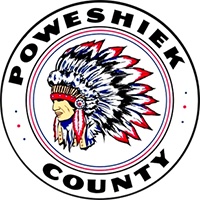John Clayton grew up on a farm in Poweshiek County, which he now farms. During his childhood, going to Meskwaki Pow-Wows in neighboring Tama County was the highlight of each summer. He is a 2024 candidate for Poweshiek County supervisor.
Minnesota officially adopted a new state flag on May 11, replacing the previous design, which had long been criticized for its depiction of a Native American on horseback with a spear and a white pioneer farming with a gun. The flag’s imagery was viewed by many as a symbol of Indigenous defeat and displacement, which was considered offensive by the state’s Dakota and Ojibwe tribes.
Poweshiek County in Iowa uses a caricature of a Native American as its icon. The Poweshiek County Board of Supervisors acknowledged in a public open meeting held on May 6 that the county’s icon caricature isn’t of Chief Poweshiek.
Relevant background to keep in mind: the Ku Klux Klan’s peak year was 1924, when they influenced many elections across the county, including an Iowa race for U.S. Senate. The point is that this Native American icon imagery was created during a time when racism was prevalent in the late 1800s and early 1900s. The icon sends the message that Poweshiek County was once Native American land; now, it is not. This is the same message broadcasted from Minnesota’s former flag and state seal.
Many of us have grown up seeing certain images and become desensitized to their potentially offensive nature. As a result, it can be difficult to recognize when these images contain racist elements. Unfortunately, the term “racism” can be a divisive topic, causing some people to tune out of important discussions. Additionally, some individuals on the far right have used the term “cancel culture” to criticize social justice movements, such as the removal of offensive icons.
Therefore, it is an ever-greater challenge to undertake the evolutionary process of peeling back the layers of historical background from a Native American icon to arrive at the point of seeing the truth that such icons are harmful.
The American Psychological Association calls for the retirement of all American Indian mascots, symbols, images, and personalities by schools, colleges, universities, athletic teams, and organizations due to the harmful effects of racial stereotyping and inaccurate racial portrayals.
Furthermore, the National Congress of American Indians has passed multiple resolutions that urge non-Native American organizations to eliminate Native American mascots, icons, and logos. If you want to show respect to Native Americans, it is essential to get rid of Native American icons.
Comments John Clayton presented to the Poweshiek Board of Supervisors during a meeting on May 6:
Thank you for the opportunity to discuss the topic.
“Icon images matter, particularly in our county government’s work to make our services and public image accessible and welcoming to people of all backgrounds.”
The following are the social justice reasons to change the county’s icon. First, the icon isn’t of Poweshiek’s face.
Second, the feathered headdress isn’t of a woodland Native American culture. This headwear style is instead that of a Sioux, Cheyenne, or Crow-type culture.
Third, advocating for the county name to be changed isn’t sought. Removing a stereotyped, inaccurate portrayal delivers honor to Chief Poweshiek.
Fourth point: The National Congress of American Indians have passed numerous resolutions calling for the elimination of Native American mascots (icons, logos) by non-Native American organizations. The Meskwaki Nation are members of this National Congress of American Indians.
Fifth reason: The American Psychological Association calls for the retirement of all American Indian mascots, symbols, images, and personalities by schools, colleges, universities, athletic teams, and organizations due to the harmful effects of racial stereotyping and inaccurate racial portrayals.
To examine the county logo, the Board may consider the following steps: 1. Appoint a task force committee to research the county icon appropriateness. 2. Get a recommendation from the task force. 3. Hold a public hearing on the recommendation. 4. The county Board makes the final decision.
Thank you for hearing the concern about the county icon. Thank you for considering action on county’s icon image.

